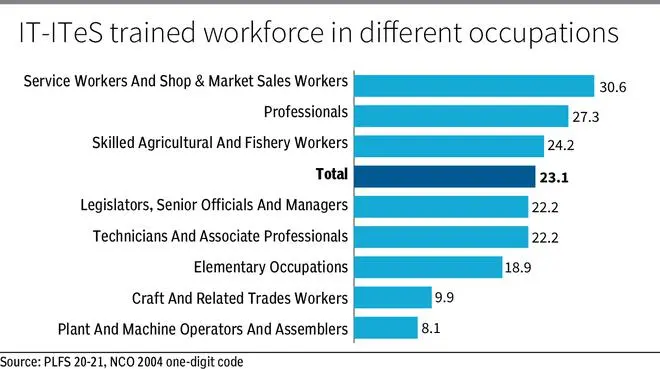As the pace of technological change continues to accelerate and demand for such skills outstrips supply, it is time to educate everyone on computer-based skills. The data from the National Sample Survey: Multiple Indicator Survey and Labour Force Periodic Survey (2020-21) indicate a need to broaden the coverage of IT or computer-based training across various sectors.
The World Economic Forum predicts that while 85 million jobs will become obsolete by 2025, technological advancements in artificial intelligence and other fields will lead to the creation of 97 million new jobs. This implies that the number of new jobs will surpass the number of jobs that will be lost. It is expected that the role of machines in the division of labour will continue to increase, especially for repetitive and routine tasks.
As a result, countries that can produce a highly skilled workforce in computer-based technologies will have a competitive edge in the global economy. The jobs of the future are expected to rely more on data-driven and machine-powered processes.
Revamping skills
To adapt to the changing job market, it is crucial to restructure the entire skill development system. It is imperative to focus on upskilling the workforce with an eye on emerging technologies and the future of work.
India has an advantage over other countries due to its sizeable working-age population and a significant youth demographic. However, to fully realise this advantage, there is a need for a strategic investment, particularly in the reskilling of the workforce to keep up with the digital transformation.
Given that digital transformation is expected to have a widespread impact, not just on the youth but on a large segment of the workforce, individuals working in various fields will require IT or computer-based skills to remain competitive in the job market.
The NSS 78th Round data (2020-21) indicate a clear need for skilling programmes, particularly in the area of computer and IT skills. For instance, less than 42 per cent of the country’s youth has a basic understanding of copying or moving files or using copy and paste tools on a computer.
Additionally, only 10 per cent and 8.6 per cent of youth have knowledge of basic arithmetic formulae in a spreadsheet and creating an electronic presentation using presentation software, respectively. Moving to more complicated task, the data indicate that only 2.4 per cent of youth have programming skills.
Moreover, the need for computer or IT skills goes beyond these basic abilities. Highly specialised areas like artificial intelligence and automation in manufacturing and production processes require significant training and experience. The recently conducted Periodic Labour Force Survey (PLFS) in 2021 provides insights into vocational and technical training, highlighting a skilled workforce in various fields. The data indicate a disproportionate enrolment of youth in IT-ITeS vocational or technical courses, with a significantly high percentage of 34.7 per cent, in comparison to other courses.

Improving training
Approximately 30 per cent of the trained workforce in different fields have IT training, yet 29 per cent of individuals with such training are unemployed, pointing towards either inadequate training content or poor training quality that results in low employability.
Moreover, the data suggest that IT-trained individuals are not placed in one specialised area but rather in different occupation categories. Notably, the proportion of individuals with IT skills is the largest in most of the occupation category when compared to other vocational or technical fields, suggesting that possessing IT skills has an advantage in securing employment across different occupations.
To remain competitive in the global market, it has become increasingly important for individuals from all sectors to possess specialised IT or computer skills.
The government, recognising this, has implemented several skilling programmes, such as the Skill India Mission and Pradhan Mantri Kaushal Vikas Yojana (PMKVY) 4.0. These initiatives aim to train and certify millions of individuals in various vocational skills, including IT and digital skills, with a focus on emerging technologies like artificial intelligence, mechatronics and robotics.
However, the PLFS (2021) data show that only 4.1 per cent of youth received formal training in different fields. As the digital transformation impacts all sectors, it is imperative that a large section of the workforce undergoes significant skilling, upskilling, or reskilling to compete in the digital economy.
The writer is Senior Research Analyst, National Council of Applied Economic Research, Delhi




Comments
Comments have to be in English, and in full sentences. They cannot be abusive or personal. Please abide by our community guidelines for posting your comments.
We have migrated to a new commenting platform. If you are already a registered user of TheHindu Businessline and logged in, you may continue to engage with our articles. If you do not have an account please register and login to post comments. Users can access their older comments by logging into their accounts on Vuukle.